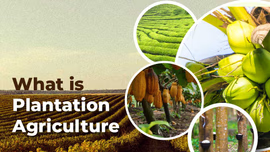What is Crop Insurance – Benefits & How to Claim?

Crop insurance provides risk coverage against any expected crop failure due to natural causes. In this article, we will get a better understanding of crop insurance, its benefits, and government schemes to help farmers during such losses.
Table of Contents
- Need for Crop Insurance
- What is Crop Insurance?
- Why is Crop Insurance Beneficial for Farmers?
- Easy Steps to Apply for Crop Insurance
- What are the Documents Required?
- How to Apply Online?
- How to Claim Insurance? (Online Process)
- Government Schemes for Crop Insurance
- Conclusion
Need for Crop Insurance
Agriculture provides a daily source of income for more than 50 per cent India's population and sustains the livelihoods of over 600 million people in the nation. It also plays an important role in strengthening the country's GDP. In 2024, agriculture and allied industry contributed around 16% to India’s GDP. Due to these reasons, agriculture is often regarded as the ‘backbone of Indian economy’, with farmers seen as essential contributors to its growth.
Farming is an occupation highly susceptible to a number of risks largely due to its dependence on nature. Many factors such as uncertain weather, a pest outbreak, or crop raiding can have a detrimental impact on the season’s harvest. Therefore, in order to mitigate such losses, the government has introduced crop insurance or agriculture insurance which provides risk coverage against crop failure and offers a safety net to farmers by compensating for such losses.
What is Crop Insurance?
Crop insurance offers safety coverage to farmers in any case of crop damage. It is a risk management strategy that financially compensates farmers for crop damage caused by natural events such as drought, hailstorm, farm fires, animal raiding (damage caused by wild animals), pest-infestation, or diseases. Crop insurance in India provides cover against damage to standing as well as post-harvest crops. It ensures that farmers recover financially and continue their operations despite the challenges.
Why is Crop Insurance Beneficial for Farmers?
India’s farming sector is predominantly dependent on climate. However, the rapidly approaching threat of climate change has become a major concern for farmers. Unpredictability of weather can often translate into huge financial losses, which makes crop insurance more important than ever.
Here are some of the benefits of crop insurance for farmers:
Financial Protection Against Risk of Crop Failure: Crop insurance helps cover losses due to drought, flood, hailstorm, pests, prevented sowing, post-harvest damage and localized calamities. It offers protection to farmers throughout all stages from sowing to post harvest.
Encourages Investment: When there is a reduced risk of crop failure, it prompts farmers to make better investments. Whether in higher quality seeds, fertilizers and better technology to help improve farm productivity.
Easy Credit Access to Farmers: Crop insurance can often be used as collateral or a risk mitigation tool for lenders and banking facilities. Insured farmers are more likely to receive loans from banks and financial institutions than those without insurance.
Government Support: Many crop insurance schemes are subsidized by the government, making them affordable for farmers. Programs like PMFBY (Pradhan Mantri Fasal Bima Yojana) in India offer wide coverage at low premiums.
Easy Steps to Apply for Crop Insurance
What are the Documents Required?
Before applying for insurance, make sure that you have all the necessary documents required before submission. These include:
- Aadhar Card (For identity verification)
- Land Ownership Records or lease agreements.
- Crop Sowing Certificate
- Bank Account Details
- Passport Size Photographs.
- Other Identification Proofs (Voter ID, Ration Card, Driving License etc.)
How to Apply Online?
Here’s a step-by-step process on how to apply for crop insurance in India.
Step 1: Go to pmfby.gov.in website
Step 2: Click on the ‘Farmer corner’, and login with your mobile number. If you’re a new user, choose ‘Guest farmer’.
Step 3: Select “apply for crop insurance yourself”.
Step 4: Fill in all the required details include personal information, bank details, land information and crop specifics.
Step 5: Upload all the necessary documents
- Aadhar Card
- Land ownership proof or tenancy agreement
- Sowing Certificate (If available).
- Bank A/c details
Step 6: Pay the premium amount as per your farm area and crop.
Step 7: After submitting the application, you will receive acknowledgement number and receipt for future tracking.
How to Claim Crop Insurance? (Online Process)
Report Loss (Within 72 Hours): Report the crop damage within 72 hours of occurrence. Visit the Nation Crop Insurance Portal (NCIP) or report through your bank or local agricultural office.
Share Key Information: Share all the key information including application number (reference number), policy details, date, cause of loss, affected land, crop type, and area.
Survey of Damaged Crop:
- For localized or post-harvest losses, an assessing officer is appointed within 48 hours to conduct field surveys.
- For area based/widespread calamities losses are assessed through aggregate yield data.
Claim settlement: Compensation is processed within 21 days (widespread risks) and 15 days (localized/post-harvest events).
Receive Compensation: Approved claims are paid directly to your bank account.
Government Schemes for Crop Insurance
In the table below we’ve listed some of the popular crop insurance schemes in India.
|
Scheme Name |
Objective |
Risk Coverage |
|
Pradhan Mantri Fasal Bima Yojna (PMFBY) |
Provide comprehensive insurance coverage to farmers against crop failure. |
- Prevented Sowing/Planting |
|
Weather Based Crop Insurance Scheme (WBCIS) |
Insurance against adverse weather conditions affecting crop yields. |
- Rainfall |
|
Coconut Palm Insurance Scheme (CPIS) |
Insure coconut palms against natural disasters, pests, and diseases. |
- Storm, hailstorm, cyclone, typhoon, tornado, heavy rains |
Conclusion
Crop insurance plays an important role in protecting farmers and safeguarding their livelihood from a myriad of risks that threaten agriculture productivity. However, with the help of government introduced schemes such as PMFBY, it has helped empower farmers to adopt better farming practices without worrying about crop failure or falling into financial debt.


Related Blogs












